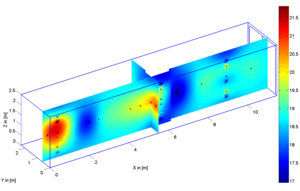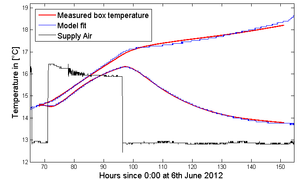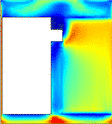Prediction and risk reduction for hot spots
Climacteric fruits, such as bananas, can create tremendous amounts of heat by respiration. If the generated heat per box or pallet exceeds the amount of heat that can be removed by cooling, this creates hot spots, where the temperature increases beyond control. In turn, the increased temperature accelerates the biological processes.
(Spatial temperature distribution and zones with deficient cooling)
Thermal model
In order to analyse and quantify the conditions that lead to a hot spot, it is necessary to extract the effects of biological heat generation and cooling from the measured temperature curves. A thermal model was developed during our project, which enables the estimation of heat generation and removal as separate parameters [1]. The data in the table on the right were calculated from the temperatures recorded from our field tests. Bananas produce approximately 50 Watts per tonne thermal energy under a normal atmosphere. This value decreases under a controlled atmosphere, but increases with advanced ages of fruits.
|
Condition |
Generated heat |
|
Controlled atmosphere (4.5% CO2 / 3% O2) |
16.1 W/t |
|
Film packing/Banavac (4% CO2 / 17% O2) |
24.0 W/t |
|
Normal atmosphere |
50.3 W/t |
|
Ripening at 15°C |
70 ... 115 W/t |
|
Ripening at 17°C |
185 ... 210 W/t |
Improved packing and stowage
The airflow from the cooling unit can remove 60 Watts per tonne for standard packing conditions, or 1 kW for the full container load, which is less than 10% of the nominal cooling capacity of the refrigeration unit. This poor relationship indicates that the airflow conditions inside a container are far from being optimal. During the project we showed that the heat removal from the banana boxes can be increased by up to 50%, by a combination of a new box design, the use of spacers to create gaps between pallets and a modified layout to stow the pallets inside the container [![]() 1].
1].
|
Packing / Stowage |
Removed heat |
|
Standard packing |
58,7 W/t |
|
Blocked gaps |
41,6 W/t |
|
Gap of 3 cm |
68,0 W/t |
|
Improved boxes, gaps and chimney layout |
92,1 W/t |
Container ripening
The feasibility of carrying out the ripening process directly inside the container was demonstrated during the project with three practical tests. During the last 2 days of ripening, when the heat generation is the highest, the temperature set point can be reduced by 0.5°C. With the improved packing and stowage, it is then possible to fully compensate for the heat production during ripening at 15°C.
Air flow simulation
A computational fluid dynamics simulation in COMSOL provided additional proof for the advantage of the modified stowage layout [![]() 2]. The simulation showed that the airflow speed is increased in the upper layers of the pallets, where the highest temperatures are usually observed. Furthermore, the simulation provided an explanation for the deficient cooling of the two pallets stowed directly at the back end of the container. An eddy in this section largely reduces the air exchange.
2]. The simulation showed that the airflow speed is increased in the upper layers of the pallets, where the highest temperatures are usually observed. Furthermore, the simulation provided an explanation for the deficient cooling of the two pallets stowed directly at the back end of the container. An eddy in this section largely reduces the air exchange.
Eddy on the side of the cooling unit and increased airflow in the upper layers of a pallet (orange/red = high air speed)
Wireless airflow sensors
The necessary parameters for the airflow simulation were adjusted according to the measurements obtained from a set of wireless airflow sensors. The devices were based on a sensor element that was developed at IMSAS. The sensors were integrated into the wireless network for temperature monitoring [![]() 3].
3].
Relevant publications
- Jedermann, R., Geyer, M., Praeger, U., Lang, W.: Sea transport of bananas in containers – Parameter identification for a temperature model, Journal of Food Engineering, April 2013, Vol. 115(3) 3,pp. 330–338, DOI:
 10.1016/j.jfoodeng.2012.10.039. [
10.1016/j.jfoodeng.2012.10.039. [ pdf]
pdf] - Issa, S.; Lang, W.: Airflow Simulation Inside Reefer Containers. In: Kotzab, H.; Pannek, J.; Thoben, K.-D.,(eds.): Dynamics in Logistics, Springer International Publishing, 2016, pp. 303-311. DOI:
 10.1007/978-3-319-23512-7_29 [
10.1007/978-3-319-23512-7_29 [ pdf]
pdf] - Lloyd, C.; Jedermann, R.; Lang, W.: Airflow Behavior Under Different Loading Schemes and Its Correspondence to Temperature in Perishables Transported in Refrigerated Containers. In: Freitag, M.; Kotzab, H.; Pannek, J.,(eds.): Dynamics in Logistics: Proceedings of the 5th International Conference LDIC, 2016 Bremen, Germany, Springer International Publishing, Cham, 2017, pp. 481-490. DOI:
 10.1007/978-3-319-45117-6_42 Presented at: 4th International Conference on Dynamics in Logistics (LDIC 2014), Bremen, Germany [
10.1007/978-3-319-45117-6_42 Presented at: 4th International Conference on Dynamics in Logistics (LDIC 2014), Bremen, Germany [ pdf].
pdf].
Contact
Reiner Jedermann, Institute for Microsensors-, actuators and -systems, University of Bremen, ![]() Email
Email













